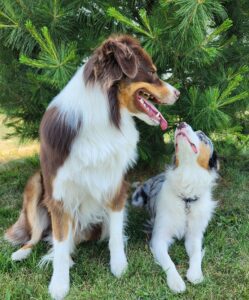Dealing with excessive dog barking can be a common challenge for dog owners. Understanding the triggers and employing effective training methods are crucial for curbing this behavior. This article will explore various scenarios that may lead to barking and provide tips for training your dog to stop.
Attention-Seeking Barking
In the realm of canine behavior, the principle of reinforcement plays a pivotal role, particularly in attention-seeking barking. Dogs are prone to repeating behaviors that receive reinforcement, making it important for owners to adopt a strategic approach to addressing this common issue. This section explores effective methods to manage attention-seeking barking, emphasizing the significance of consistency in shaping your dog’s behavior.
Navigating Attention-Seeking Barking: When your dog engages in attention-seeking barking, the initial response is crucial. It’s recommended to resist the urge to react immediately. As any form of attention – positive or negative – can inadvertently reinforce this behavior. Instead, employing a consistent and measured approach becomes paramount in guiding your dog away from attention-seeking tendencies.
The Power of Ignoring: A simple yet potent strategy involves ignoring the barking and physically leaving the room. By disengaging from the behavior, you convey a clear message to your dog that attention-seeking barking will not garner the desired response. This intentional act of ignoring acts as a powerful tool in extinguishing the behavior over time.
Doorbell and Knock-Triggered Barking
Doorbell and knock-triggered barking are common behaviors in dogs. Often stemming from associations formed over time. Initially, these sounds held no meaning for your puppy, but with repeated exposure, they learned to link the noise with people entering the house. To address this, consider training the “place” command, where your dog remains in a designated area until given a release command.
Excitement About Guests: Dogs may bark out of excitement when anticipating guests. To address this, practice with your dog by keeping them at a distance from the door using a leash. Teach them an alternate behavior, such as sitting or lying down. Reward and praise them for the desired behavior.
Reluctance to Meet People: Other dogs may not be eager to meet guests due to territoriality or fear. If your dog barks from a distance, signaling guests to stay away, it’s essential to manage their reactions. Help your dog desensitize to the doorbell or knocking sounds by using recorded sounds at a low volume, gradually increasing it. Reward your dog for not reacting. With consistent practice, they’ll associate these sounds with positive experiences, anticipating treats for calm behavior during doorbell rings or knocks.
Watchdog Behavior: Some dogs bark at the doorbell or knock as a protective instinct, serving as watchdogs. These dogs may give a few barks and quiet down upon their owners’ acknowledgment. For dogs overly excited about guests, practice distance training using a leash and reinforcing alternate behaviors like sitting or lying down. Gradually expose them to a doorbell or knocking sounds without guests entering, rewarding positive behaviors with treats and praise.
The Mystery of Barking at Nothing
When your dog appears to bark at nothing, consider the possibility of external stimuli that may be imperceptible to humans. Noises originating from nocturnal critters like raccoons, deer, rabbits, mice, or other rodents could be the culprit, especially during the night when these creatures are most active. If your dog persistently barks in low-light conditions, it might indicate their acute awareness of these critters in or around your home.
Heightened Auditory Perception: Dogs boast a remarkable auditory capacity, enabling them to hear sounds at frequencies barely audible to humans. Factors such as distant sounds, including another dog barking in the neighborhood or a siren miles away, may trigger your dog’s barking. Their ability to pick up on sounds through barriers like windows, doors, and walls adds another layer to their sensory experiences.
Navigating Canine Sensory Realm: Understanding that your dog’s reactions are grounded in their heightened sensory perceptions allows you to navigate and address their behavior more effectively. By acknowledging the intricacies of their auditory and visual awareness, you can foster a supportive environment that accommodates their unique sensitivities.
Conclusion:
Successfully addressing your dog’s barking requires patience, understanding, and consistent training. Identifying the specific triggers and implementing targeted training methods will contribute to a quieter and more harmonious living environment for both you and your companion. Remember, a well-trained dog is a happy dog!








